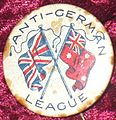Anti-German sentiment facts for kids
Anti-German sentiment (also known as Germanophobia or Teutophobia) is a feeling of dislike or fear towards Germany, Germans, their culture, or the German language. The opposite feeling, which is a liking for Germany, is called Germanophilia.
This feeling started to grow in the mid-1800s. At that time, Germany became a united country. This made Germany a strong competitor to other powerful nations in Europe. People in other countries worried that Germany, led by figures like Otto von Bismarck and Helmuth von Moltke, wanted to become the most powerful country in Europe. Bismarck brought Germany together in 1871 and was its first leader, called a Chancellor, until 1890.
Contents
Why Did Anti-German Feelings Start?
Germany Becomes a Strong Nation
Before 1871, Germany was not one country. It was many smaller states. Otto von Bismarck was a key leader who helped unite these states into a single, powerful nation. This new Germany quickly grew strong in its economy, military, and influence across Europe. Other major European countries saw this as a challenge. They worried about Germany's growing power and its possible plans.
Key Leaders: Bismarck and Moltke
Otto von Bismarck was a very clever politician. He used both diplomacy and military strength to unite Germany. He believed in making Germany strong and respected.
Helmuth von Moltke the Elder was a brilliant military leader. He was in charge of the Prussian Army for 30 years. He led the army to victories in important wars, like the Austro-Prussian War and the Franco-Prussian War. These wins helped Germany become a major military power. Moltke was also very interested in railways and was one of the first to use them for moving soldiers and supplies quickly. He is called "Moltke the Elder" to tell him apart from his nephew, Helmuth von Moltke the Younger, who led the German Army at the start of World War I.
Anti-German Sentiment in Wars
World War I (1914-1918)
Anti-German feelings became much stronger during World War I. Germany was seen as the main enemy by many countries, including Britain, France, and the United States. Propaganda, which is information used to promote a political cause, often showed Germans in a negative way. German culture, music, and even the German language were sometimes looked down upon or banned in some places. For example, some towns in countries fighting Germany changed their German-sounding names.
World War II (1939-1945)
Anti-German sentiment reached its peak during World War II. The actions of Nazi Germany and its leader, Adolf Hitler, caused widespread hatred and fear. The terrible crimes committed by the Nazis, such as the Holocaust, led to very strong negative feelings towards Germany and Germans around the world. After the war, many people felt that Germany needed to be held responsible for its actions.
After the Wars
After World War II, Germany was divided into two parts: East Germany and West Germany. Over time, West Germany became a democratic country and worked hard to rebuild its reputation. It apologized for the actions of the Nazis and focused on peace and cooperation with other nations.
Today, anti-German sentiment is much less common. Germany is a respected member of the European Union and a major player in global politics and economics. However, some negative feelings can still appear, especially during times of economic tension or political disagreements in Europe.
Images for kids
-
German shelling of Reims Cathedral in France early in the First World War.
-
A 1917 comic strip where a character breaks a clown doll because it was made in Germany.
See also
 In Spanish: Antigermanismo para niños
In Spanish: Antigermanismo para niños









